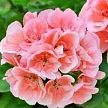
Pelargonium
Flowering - at any time of the year
| Latin name | Pelargonium |
| Homeland | South Africa |
| Family | Geraniaceae |
| Cultivation | simple |
| Location | very well lit, even in the open sun |
| Temperature | not lower than 0 °C |
| Watering | regular plentiful in summer, sparse in winter |
| Flowering time | from spring to late autumn |
| Height | up to 1.5 m |
| Transplanting | in May |
| Appearance maintenance | regularly remove dust from the leaves |
Without a doubt, in Europe, pelargonium is the most famous potted beautifully blooming plant due to its long flowering period, which in mild climates lasts until late autumn. The genus Pelargonium includes about 250 species native to South Africa, where they grow on poor stony soils at altitudes up to 700-800 m above sea level. K. Linnaeus gave the first 20 species introduced to Europe the name "Geranium": later it was assigned to another genus of this family. Modern decorative hybrids are obtained from 3 species: Pelargonium zonal (Pelargonium zonale), thyroid pelargonium (P. peltatum), and large-flowered pelargonium (P. grandiflorum). They are grouped into zonal, ivy-shaped, large-flowered and fragrant pelargoniums used in the cosmetics industry and perfumery.
Without a doubt, in Europe, pelargonium is the most famous potted beautifully blooming plant due to its long flowering period, which in mild climates lasts until late autumn. The genus Pelargonium includes about 250 species native to South Africa, where they grow on poor stony soils at altitudes up to 700-800 m above sea level. K. Linnaeus gave the first 20 species introduced to Europe the name "Geranium": later it was assigned to another genus of this family. Modern decorative hybrids are obtained from 3 species: Pelargonium zonal (Pelargonium zonale), thyroid pelargonium (P. peltatum), and large-flowered pelargonium (P. grandiflorum). They are grouped into zonal, ivy-shaped, large-flowered and fragrant pelargoniums used in the cosmetics industry and perfumery.
Cultivation
Large-flowered pelargonium can be grown both in a pot and in a flower bed. The exception is a few varieties and varieties (for example, 'City of Bern’), which can be grown at home, but always away from heat sources. In milder climates, the plant can safely spend the winter outdoors. But in colder areas, plants should be removed to a cool and dry place, removed from the ground, always with a lump, and, after cleaning from dry leaves, placed in a wooden box, close to each other. In March-April, when the growing season resumes, you should strongly shorten the shoots. Every year, before resuming the growing cycle for potted plants, it is useful to partially renew the soil.
Location
Pelargoniums require a lot of light, they tolerate open sun well, especially in a dry and well-ventilated place.
Temperature
Pelargoniums are plants that prefer warm, moderately humid climates and tolerate low, but not negative temperatures. With high humidity, the plant can get damaged from the cold, even at plus temperatures.
Watering
The irrigation regime depends on the time of year. Plants are constantly watered, otherwise the leaves turn yellow or are damaged by the sun. In winter, watering is gradually reduced, especially if you want to keep the plant until the next season. Fertilizers are also applied in the same way. In summer, once a week, a liquid complex fertilizer is added to the water for irrigation (10 g per bucket), in autumn and winter this is done less often.
The irrigation regime depends on the time of year. Plants are constantly watered, otherwise the leaves turn yellow or are damaged by the sun. In winter, watering is gradually reduced, especially if you want to keep the plant until the next season.
Fertilizers are also applied in the same way. In summer, once a week, a liquid complex fertilizer is added to the water for irrigation (10 g per bucket), in autumn and winter this is done less often.
Transplant
For planting in a pot or transplanting large-flowered pelargonium into another container, a soil mixture of 2 parts of garden soil and 1 peat or rotten foliage, filled with a liquid complex balanced fertilizer (30 g per bucket of soil) is ideal. Both a potted plant and an open-ground plant require good drainage to avoid water stagnation. The optimal planting date is May.
Care
In order to ensure the lush flowering of large-flowered pelargonium, it is necessary to remove dry or damaged leaves and faded inflorescences.
Reproduction
It is produced both vegetatively (by cuttings) and by seeds. For cuttings in the period from July to September, cut off vertical shoots with a length of 8-10 cm. In a warm climate, such an operation is performed in March from plants that have survived the winter. Cuttings are rooted in pots filled with a mixture of sand and peat, taken in equal parts, constantly maintained in a moist state. When the roots appear, they should be transplanted to another pot and pinched to promote the growth of side shoots. Seeds are sown in a container filled with light soil that is kept moist all the time. The room temperature should be 20-22 °C. As soon as the shoots appear, they should immediately be moved to a lighted room with a temperature of 15 °C. Another 3-4 months - and the plants will bloom.
Diseases
Large-flowered pelargonium is easily susceptible to fungal diseases - gray rot, rust and root rot, which are eliminated with the help of appropriate fungicides. Diseases appear when water stagnates or humidity is too high, more often in spring. Aphids and mites that carry viral diseases from one plant to another are dangerous pests. They get rid of them with special preparations.
Acquisition
Potted pelargoniums are best bought in the period from mid-March to the end of May. Check the condition of the internodes (the part of the stem located between two adjacent leaf attachment points): they should not be too long.